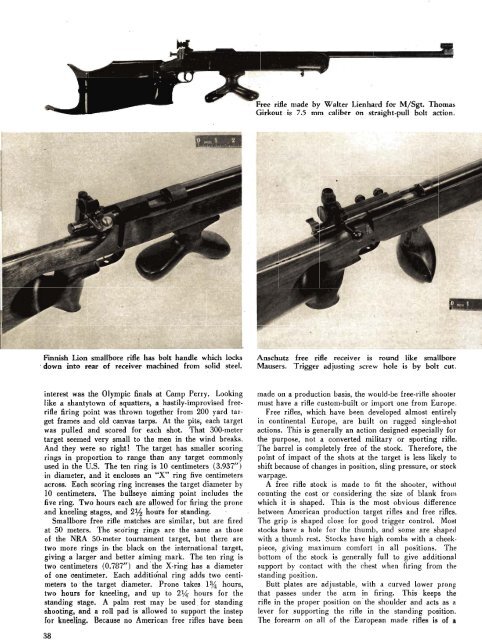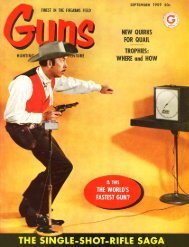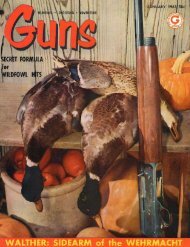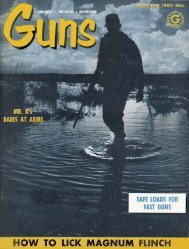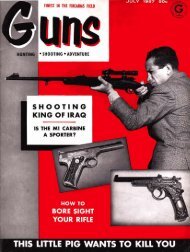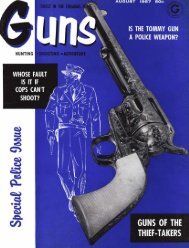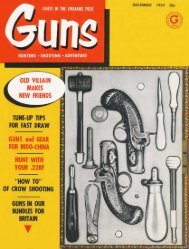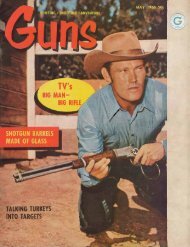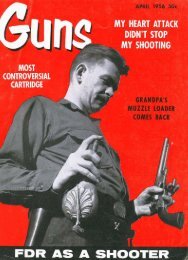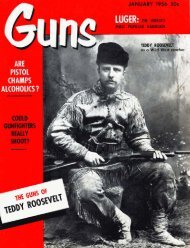You also want an ePaper? Increase the reach of your titles
YUMPU automatically turns print PDFs into web optimized ePapers that Google loves.
F i<br />
J.<br />
Free d e ma& by Walter Lienhard for MIS@. Thomas<br />
,Grkout is 7.5 mm caliber on straight-pull bolt action.<br />
Lion smallbore d e has bolt handle which lo& Anschutz free Ae receiver is round like smallbore<br />
. down into rear of receiver machimed from solid steel. Makrs. Trigger adjusting screw hole is by bolt cut.<br />
interest was the Olympic finals at Camp Perry. hoking<br />
like a shantytown of squatters, a hastily-improvised freerifle<br />
firing point was thrown together from 200 yard target<br />
frames and old canvas tarps. At the pits, each target<br />
was pulled and scored for each shot. That 3Wmeter<br />
target seemed very small to the men in the wind breaks.<br />
And they were so right! The target has smaller scoring<br />
rings in proportion to range than any target commonly<br />
used in the U.S. The ten ring is 10 centimeters (3.937")<br />
in diameter, and it encloses an "X" ring five centimeters<br />
across. Each scoring ring increases the target diameter by<br />
10 centimeters. The bullseye aiming pint includes the<br />
five ring. Two hours each are allowed for firing the prone<br />
and heeliig stages, and 2% hours for standing. .<br />
Smallbore free rifle matches are similar, but are fired<br />
at !30 meters. The scoring rings are the same as those<br />
of the NRL~ 5Cbmekr tournament target, but there are<br />
two more rings ixb the black .on the international target,<br />
giving a larger and better aiming mark. The ten ring is<br />
two centimeters (0.787") and-the X-ring has a diameter<br />
of one centimeter. Each additi6nal ring adds two centimeters<br />
to.the target diameter. Prone takes 1% hours,<br />
two hours for kneeling, and up to 2lh hours for the<br />
standing stage. A palm rest may be used-for standing<br />
shooting, and a roll pad is allowed to support the instep<br />
for kneeling. Because no American free rifles have been<br />
made on a ~roduction basis. the would-be free-rifie shooter<br />
must have a rifle custom-built or import one from Europe.<br />
Free rifles, which have been developed almost entirely<br />
in continental Europe, are built on rugged singlpshot<br />
actions. This is generally an action desiged especially for<br />
the purpose, not a converted military or sporting rifle.<br />
The barrel is completely free of the stock. Therefore, the<br />
point of impact of the shots at the target is less likely to<br />
shift because of changes in position, sling pressure, or stock<br />
warpage.<br />
A free rifle stock is made to fit the shooter, withou~<br />
counting the cost or considering the size of blank from<br />
which it is sha~ed. This is the most obvious difference<br />
between American production target rifles and free rifles.<br />
The grip is shaped close for good trigger control. Most<br />
stocks have a hole for the thumb, and some are shaped<br />
with a thumb rest. Stocks have high combs with a cheekpiece,<br />
giving maximum comfort -in all positions. The<br />
bottom of the stock is generally full to give additional<br />
support by contact with-the chist when &ing from the<br />
standing position.<br />
Butt plates are adjustable, with a curved lower prong<br />
that Dasses under the arm in firing. This kee~s the<br />
rifle [n the proper position on-the shoilder and acb as a<br />
lever for supporting the rifle, in' the standing position.<br />
The forearm .on all of the European made rifles is of a


